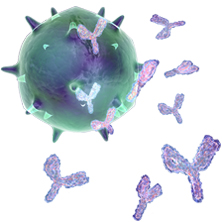Chauhan N, Malik A, Sharma S. Environmental Science and Pollution Research, 2017 ABSTRACT: In present study, the essential oils such as Mentha piperita (mentha oil, M.O), Cymbopogan citratus (lemongrass oil, LG.O), Citrus sinensis (orange oil, O.O), and Eucalyptus globulus (eucalyptus oil, E.O) were evaluated for repellency against housefly (Musca domestica) in a specially designed chamber. Further, to… Read more »

This system includes the lymph nodes, white blood cells, lymphatic vessels, thymus gland, bone marrow, spleen and leukocytes. Common disorders include anything with bacterial, viral or fungal origins, leukemia, allergic reactions and autoimmune diseases like lupus or rheumatoid arthritis.
Insecticidal activity of camphene, zerumbone and α-humulene from Cheilocostus speciosus rhizome essential oil against the Old-World bollworm, Helicoverpa armigera
Benelli G, Govindarajan M, Rajeswary M, Vaseeharan B, Alyahya SA, Alharbi NS, Kadaikunnan S, Khaled JM, Maggi F Ecotoxicology and Environmental Safety, 2017 ABSTRACT: The fast-growing resistance development to several synthetic and microbial insecticides currently marketed highlighted the pressing need to develop novel and eco-friendly pesticides. Among the latter, botanical ones are attracting high research… Read more »
Essential oils as antibacterial agents against food-borne pathogens: Are they really as useful as they are claimed to be?
Santos MIS, Martins SR, Veríssimo CSC, Nunes MJC, Lima AIG, Ferreira RMSB, Pedroso L, Sousa I, Ferreira MASS Journal of Food Science and Technology, 2017 ABSTRACT: Most studies evaluating the use of essential oils (EO) as antibacterial agents focus mainly on minimal inhibitory concentrations (MIC) rather than minimal bactericidal concentrations (MBC). In this work, we compared MICs… Read more »
Antifungal and Anti-Biofilm Activity of Essential Oil Active Components against Cryptococcus neoformans and Cryptococcus laurentii
Kumari P, Mishra R, Arora N, Chatrath A, Gangwar R, Roy P, Prasad R Frontiers in Microbiology, 2017 ABSTRACT: Cryptococcosis is an emerging and recalcitrant systemic infection occurring in immunocompromised patients. This invasive fungal infection is difficult to treat due to the ability of Cryptococcus neoformans and Cryptococcus laurentii to form biofilms resistant to standard antifungal treatment…. Read more »
Modulation of diverse oncogenic transcription factors by thymoquinone, an essential oil compound isolated from the seeds of Nigella sativa Linn
Shanmugam MK, Arfuso F, Kumar AP, Wang L, Goh BC, Ahn KS, Bishayee A, Sethi G Pharmacology Research, 2017 ABSTRACT: Thymoquinone (TQ), isolated almost fifty years ago, is the main bioactive constituent of black seed essential oil extracted from the seed of Nigella sativa. TQ has been shown to have promising effects against a variety of inflammatory… Read more »
Antifungal activity of Myrtus communis against Malassezia sp. isolated from the skin of patients with pityriasis versicolor
Barac A, Donadu M, Usai D, Spiric VT, Mazzarello V, Zanetti S, Nikolic E, Stevanovic G, Popovic N, Rubino S Infection, 2017 ABSTRACT: The increasing incidence of fungal infections and antifungal resistance has prompted the search for novel antifungal drugs and alternative agents. We explored the antifungal activity of Myrtus communis essential oil (EO) against Malassezia sp…. Read more »
Chemistry, Antimicrobial Mechanisms, and Antibiotic Activities of Cinnamaldehyde against Pathogenic Bacteria in Animal Feeds and Human Foods
Friedman M Journal of Agricultural and Food Chemistry, 2017 ABSTRACT: Cinnamaldehyde is a major constituent of cinnamon essential oils produced by aromatic cinnamon plants. This compound has been reported to exhibit antimicrobial properties in vitro in laboratory media and in animal feeds and human foods contaminated with disease-causing bacteria including Bacillus cereus, Campylobacter jejuni, Clostridium perfringens, Escherichia… Read more »
Effect of oregano essential oil and carvacrol on Cryptosporidium parvum infectivity in HCT-8 cells
Gaur S, Kuhlenschmidt TB, Kuhlenschmidt MS, Andrade JE Parasitology International, 2017 ABSTRACT: Cryptosporidium parvum is the second leading cause of persistent diarrhea among children in low-resource settings. This study examined the effect of oregano essential oil (OEO) and carvacrol (CV) on inhibition of C. parvum infectivity in vitro. HCT-8 cells were seeded (1×106) in 96-well microtiter plates… Read more »
In vitro Protoscolicidal Effects of Cinnamomum zeylanicum Essential Oil and Its Toxicity in Mice
Mahmoudvand H, Mahmoudvand H, Oliaee RT, Kareshk AT, Mirbadie SR, Aflatoonian MR Pharmacognosy Magazine, 2017 BACKGROUND: This study investigates the scolicidal effects of Cinnamomum zeylanicum essential oilagainst the protoscoleces of hydatid cysts and its toxicity in the mice model. MATERIALS AND METHODS: Gas chromatography/mass spectroscopy analyses were used to identify the constituents of essential oil. Protoscoleces were treated… Read more »
Apoptotic Effect of Nigella sativa on Human Lymphoma U937 Cells
Arslan BA, Isik FB, Gur H, Ozen F, Catal T Pharmacognosy Magazine, 2017 OBJECTIVE: Nigella sativa is from botanical Ranunculaceae family and commonly known as black seed. Apoptotic effect of N. sativa and its apoptotic signaling pathways on U937 lymphoma cells are unknown. MATERIALS AND METHODS: In this study, we investigated selective cytotoxic and apoptotic effects of N. sativa extract… Read more »
